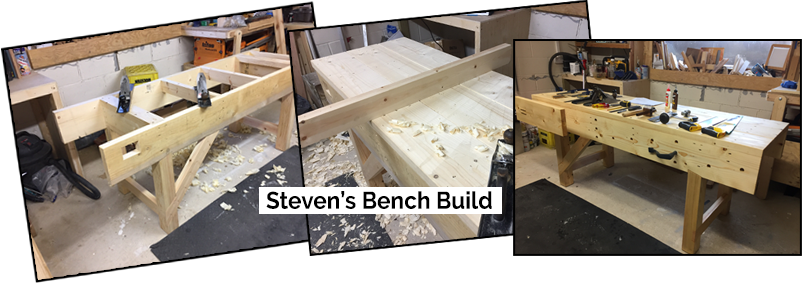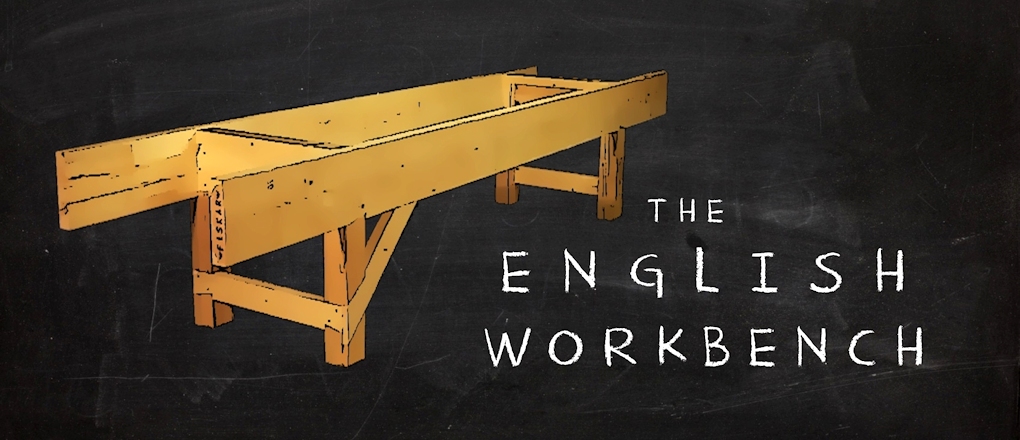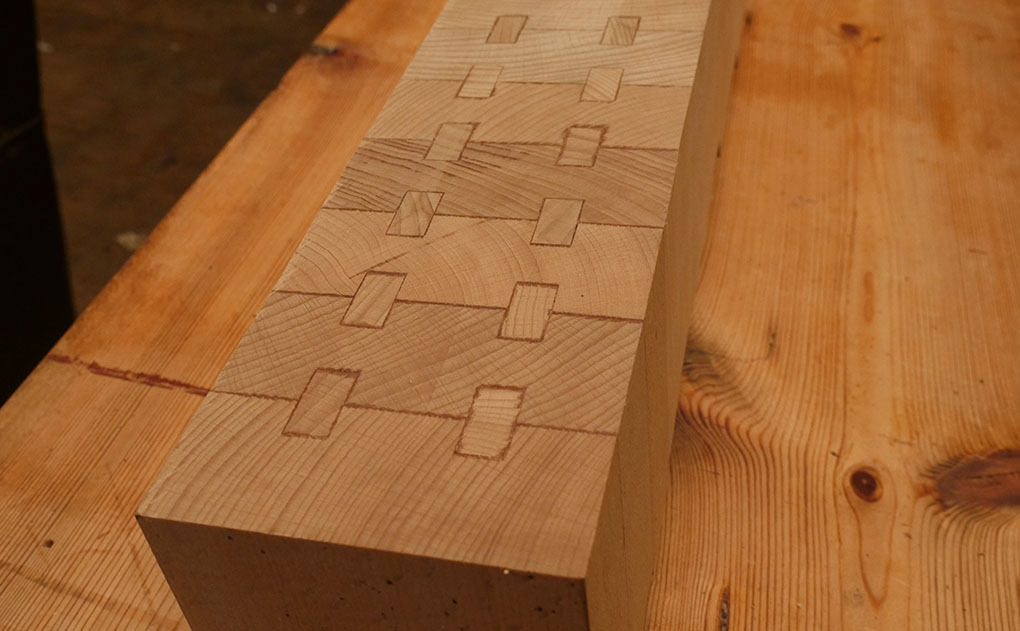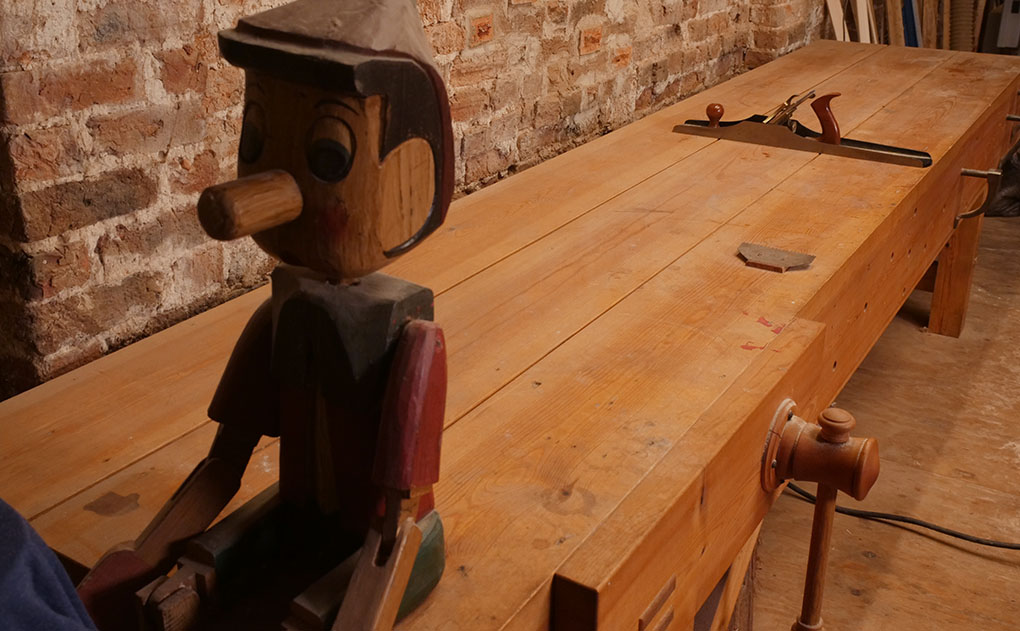
It’s been an amazing project to do and I’ve learned a lot. I can honestly say if it wasn’t for you and Helen making these amazing videos I would probably of ended up with some YouTube screwed together thing! – Steven
What is the best height for a workbench?
This is a question I get asked weekly. If you’re planning on building a workbench for your woodworking, then it’s worth giving some thought to your height before jumping in with the tools.
Getting your bench height completely wrong will cause you some discomfort and inconvenience while you work, but I always like to make it clear that it isn’t worth fretting about searching for a formula for the perfect height; an inch here or there isn’t going to make a lot of difference.
A perfect bench height can’t really exist unless you carry out only one single activity all of the time; the most practical height changes depending on the what you are doing, the tool you’re using and size & thickness of work piece.
As a general rule a lower working height is best for heavy tiring work, whilst a taller bench can save your back from stooping, when things get small and detailed. Like with many things in life a compromise is in order, and to offer some guideline, I like to suggest the following:
Your Personalised Bench Height
Stand (with your usual workshop shoes on) and keep your arms straight down the sides of your body but palms flexed up so they are parallel with the floor. Ask someone to take the measurement between the floor and underside of your palm.
This palm measurement will give you a great workbench height for most hand tool woodworking, but it can feel rather low for joinery and detailed work.
I recommend adding a couple of inches to your palm measurement, to give a nice comfortable height for a mixture of activities. If you do mainly delicate close up work, or suffer with your back, then a further inch or two would be a good idea.

When building a workbench you need to consider the type of work that it will be used for. The ‘right’ workbench height will depend on the tools and methods used.
If you’re unsure about your chosen bench height, try to get a feel for the height before starting to build your workbench. You could compare it to your present bench, a table or even just mark a line on the wall.
Bare in mind that a comfortable working height for woodworking, will likely look low when you just stand next to it. You’ll change your stance as you work, and when you require the most strength, you’re body will naturally lower as you spread your foot print and bend your knees ready for action.
Workbench Height Summary:
LOW
29″ – 30″ (74cm – 76cm) makes a practical, low workbench height for woodworking.
A low workbench is good for hand work, especially hand thicknessing, as you’re able to get your body weight over the bench.
TALL
38″ – 39″ (97cm – 99cm) makes a practical, tall workbench height.
A tall workbench is good for detailed work, cutting joinery, and for power tool use.
AVERAGE
34″ – 36″ (86cm – 91cm) tend to be the most common workbench height for woodworking.
A height in between these two extremes tends to be the most popular, particular if you do a range of activities at your workbench.
If you’re building your own workbench, we’ve got many more resources for helping you bring together your perfect bench plans.
Have a read through these links and learn how to build a bench that’s right for you.
– Make The Most Of Holdfasts – Use your workbench without a vice, by learning nifty ways for using holdfasts.
– What Wood? – Read our article on choosing the best wood for your bench build.
– Plan your Face Vice – Woodworking vices are often plagued by racking. Here we discuss how to avoid the problem of rack through correct use.
And don’t forget!
Our English Workbench Video Series takes you step by step, showing how to build your own traditional workbench.
Watch online right away, and download the PDF workbench plans.


![Simple Work Holding For Ploughing Grooves [Without a Tail Vice]](https://www.theenglishwoodworker.com/wp-content/uploads/2022/07/workholding-without-tail-vice-copy.jpg)
![Gluing Up A Workbench Leg [VIDEO]](https://www.theenglishwoodworker.com/wp-content/uploads/2022/06/gluing-up-a-workbench-leg-video.jpg)


Hi Richard,
I built mine 35″ and find this just about right for me. I built a duct board the full length of the bench, then if I ever need to have more power when heavy planing I just drop it in place. HaHa it seems to workout ok.
Nice post, thanks for this one.
Ken 😉
This is absolutely the most simple ,forward answer to bench height I have read.
How can I get the plans for the small bench you use , it looks like 5′ ?
Thank you,
Nadav
Thats twice in one week I have seen a joinery bench, the other was an american who teaches online I believe and he was teaching student and he had built his own bench already, but this joinery bench was perfect for his small workshop. When I am at college I always pick a taller bench after stooping at the start I find it so much easier to do the fine work like dovetails and veneering. The second reason this is awesome is my eyesight is starting to fail and I hate wearing glasses so this helps that too 😀
Kris
Hi Richard,
I agree with the last sentence of your first paragraph, and also think the general rule that you state is fairly good. However, I suggest that woodworkers first prioritize the tasks that they do, then empirically determine the best overall height.
Each person, after all, has all the elements needed to determine the best height for him or her: the most common processes done at the bench, personal body mechanics, and, most of all, how different heights actually feel in tryouts.
I discuss a specific process to do this here: http://www.rpwoodwork.com/blog/2011/11/21/how-to-determine-the-workbench-height-that-is-right-for-you/
Thanks for an informative blog.
Rob
I just finished what I call my “Paul Sellers” bench, it is 38 inches tall which I find the best height for whatever woodworking I do.
I spend most of my time on detail work – and a lot of hand-dovetailing – and have completely stopped the back pain it used to cause by raising my bench to a high-sounding 970mm. I got the height quite unscientifically by simply placing the bench on some old floor joists and trying it out and it’s been on them now for several years so it seems to be right. Thanks to this blog I now know why I need it so high!
My first bench was 39″ tall. It was good if I wanted to sit on a stool and work on little projects but not so good for planing. And it was so heavy that moving it was simply out of the question unless I used a floor jack to assist. I replaced it with a much shorter smaller bench which allows me to position myself better to use a hand plane; and light enough to move around easily. I also made a small bench-top bench with a Moxon style vise on it that I can clamp to the workbench when needed to allow me to work on things a little higher than the workbench top. The bench-top bench stores neatly out of the way when not in use. I have only had this setup for a few months now. I can say at this time that I am very pleased with the new arrangement. I feel I now have some versatility with my new bench and love being able to work with hand planes. I guess a person just needs to work through the different height and style options in order to determine what works for you. Unfortunately I spent good money, time, and effort building my first bench only to have to tear it apart and get rid of it. Live and learn I guess.
That’s interesting, Mike. I do use hand planes but mainly for finishing rather than prep or thicknessing. I haven’t experienced any difficulty with a high bench but that’s probably because of the kind of planing I do – if I did a lot of beefier stuff i might find the same as you. However, my work-style isn’t likely to change so I’ll probably stick with it.
I found your reference to a bench-top bench interesting, Mike. I’ve been toying with the idea of a simple version of that made from laminated MDF (to get the thickness) with a grid of 19mm holes that I can use with my bench pups and wonder-pups to get a variety of clamping arrangements especially for oddly-shaped workpieces. It would be secured by a simple strip underneath locked into the face vice. I’m waiting now until I get my new bench before I decide whether I need it or not, but I’ve often toyed with the idea. Fine box-maker Andrew Crawford has something like that with a pair of fences for quickly squaring up box carcases and I’d probably incorporate that into it, too.
Looks like the blog is still in silent running mode for a while yet. I guess no harm in you and I exchanging ideas in the interim. So about the bench-top bench…
I made a close (well maybe not so close) version of the bench-top bench featured in Fine Woodworking. Mine was constructed poorly in comparison to the one in the article but it works. The homemade Moxon style twin screw vise I used works very nice for hand cutting dovetails. The extra working height is good for using my router. I also have the top drilled for bench dogs and hold fasts. The vise has holes for bench dogs as well. The whole thing sits atop my workbench and gets clamped down on the legs when I need to use it. Otherwise, it is small and easily stores out of the way.
Here is a link to the article:
http://www.finewoodworking.com/workshop/article/a-benchtop-bench.aspx